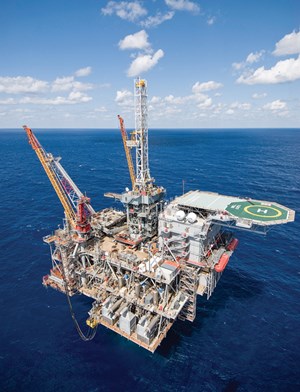Deepwater projects come of age
Through most of the last 15-years, the global E&P industry has seen a significant expansion of deepwater activity, particularly in the U.S. Gulf of Mexico, Brazil and West Africa. In all cases, the rapid development of new technologies made these deepwater areas more commercial, and accelerated their development.
In addition to technological improvements, operators were motivated globally by the size of new finds made in deepwater areas. An IHS study, covering the 2007-2012 period, found that among 481 discoveries struck during that timeframe, the initial reserves found per discovery averaged 230 MMboe.
Such was the growth of the deepwater sector that, by mid-2010, the global fleet of drillships and semisubmersibles capable of drilling in 4,000 ft or more of water had grown to 128. Most of these units were operating offshore the U.S., Brazil and West Africa. And, at the time, a further 50% expansion of the global deepwater fleet was envisioned, with 67 additional rigs under construction, on order or planned. This process continued, until the rapid oil price decline of late 2014/early 2015 put the brakes on many rig construction projects and forced numerous cancellations.

From 2000 to 2006, the share of active rigs operating offshore in Asia-Pacific, the Middle East, and Latin America grew significantly. That share held steady during the past decade. The expansion of offshore drilling in China and India accounted for most of the offshore rig growth in the Asia-Pacific region. During the early 2000s, Qatar and Iran contributed much of the growth in active Middle Eastern rigs. Saudi Arabia is responsible for a large portion of the regional growth since 2006. Mexico accounted for the growth in active rigs offshore Latin America in the early 2000s, as Pemex increased its offshore activity in hopes of stemming production declines at aging fields. Since 2006, Brazil has been responsible for much of Latin America's growth.
Most of the more recent growth in active offshore rigs outside the U.S. has occurred in Africa. Angola and Nigeria have generated much of the growth in the region after 2010. Angola has more than 10 offshore oil projects expected to come online within the next several years. Nigeria's offshore activities have focused on both deepwater and ultra-deepwater developments.
U.S. Gulf of Mexico. In this prolific deepwater region, operators over the last 15 years have installed 32 permanent deepwater production facilities. These structures have been installed in water depths ranging from 1,186 ft to 8,300 ft. The latter depth was achieved by Petrobras, which installed the Gulf’s first FPSO. In addition, at least 120 fields have gone onstream during the last 15 years. This total does not include dozens of add-on facilities and satellites installed later.
Not surprisingly, U.S. deepwater oil output has racked up impressive gains. In 2001, deepwater production averaged 864,100 bpd, representing a 56.44% share of GOM oil production. By 2014 (the last year that complete federal records are available), deepwater output had climbed 32%, to 1.141 MMbpd, for an all-time-high 81.56% share of GOM oil production. Just in the year between 2008 and 2009, deepwater output gained a remarkable 46.3%, as a number of projects went onstream. Meanwhile, natural gas output declined to about half its 2001 figure, yet the deepwater share more than doubled from 23.28% to 53.87%.
The move by operators to deeper waters prompted the departure of rigs operating in the Gulf’s shallow waters. Natural gas prospects in the Gulf also became less profitable, as the shale-driven increase in onshore supplies pushed down U.S. gas prices. The number of active GOM rigs declined from 122 in January 2000 to 41 in January 2010, before falling to 19 in June 2010 following the Deepwater Horizon accident. The active rig count in the Gulf recovered to 57 by December 2014, but then fell to 33 by mid-2015, due to the collapse in global oil prices. As of late-May 2016, the number of GOM rigs running had eroded further, to just 23.
Brazil. As late as November 2013, Brazil was still riding a wave of deepwater success. Exploration efforts coordinated by Petrobras resulted in the discovery of 37 Bbbl of new oil reserves during the previous 10 years. And more than 100 oil fields had been found. Development work continued at a feverish pace, as total country output climbed from 1.3 MMbopd in 2001 to 2.47 MMbopd in 2015.
However, an unfortunate string of setbacks derailed the Brazilian expansion. These items included lukewarm reception to the tender for Lula field; the logistical bottleneck that put offshore projects behind schedule; the corruption scandal involving Petrobras and federal officials; and the implosion of oil prices from late 2014 forward. Accordingly, in July 2015, Petrobras slashed spending 40% for the 2015–2019 period.
Nevertheless, bright spots remain. As of first-quarter 2016, Brazil still had 39 offshore projects on its planned list. Furthermore, a successful ultra-deepwater pre-salt appraisal in April 2016 flowed 16 MMcfgd and 4,000 bopd. ![]()

- Applying ultra-deep LWD resistivity technology successfully in a SAGD operation (May 2019)
- Adoption of wireless intelligent completions advances (May 2019)
- Majors double down as takeaway crunch eases (April 2019)
- What’s new in well logging and formation evaluation (April 2019)
- Qualification of a 20,000-psi subsea BOP: A collaborative approach (February 2019)
- ConocoPhillips’ Greg Leveille sees rapid trajectory of technical advancement continuing (February 2019)


